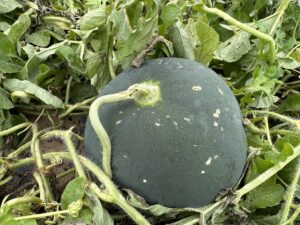There are many challenges in growing watermelons. Hail occurring right before harvest time is undoubtedly one of them. In the past weeks, there have been thunderstorms in southern Indiana. Some brought hail. Small hail causes minor damage to watermelon leaves and stems, but big hail can devastate the foliage and cause significant scarring to the fruit (Figure 1). Unfortunately, this happened to a few watermelon fields right before harvest. It is heartbreaking to see the area after being hit by the hail. We hope to help reduce the loss as much as we can. Here are some suggestions from Bob Hochmuth in his article published after the hail damage in May 2023 in FL. Bob is the IFAS Regional Specialized Extension Agent for commercial vegetable crops serving the Northeast Extension District of Florida.
Below was written by Bob in the Weekly Issue of UF/IFAS Extension Suwannee Valley Watermelon Crop Update published on May 22, 2023.
There are a couple primary considerations for fields with hail damage; one is to protect the damaged foliage with fungicides and the second is to protect the now-exposed fruit from the risk of sunburn. As far as protecting the damaged foliage from disease, it is recommended to use a broad-spectrum material such as mancozeb (Manzate®, Penncozeb®, 5-day preharvest interval) or even Inspire Super® (7-day preharvest interval) or Aprovia Top® (0-day preharvest interval), especially if these fungicides are due in the spray schedule anyway. It may also be useful to add a low rate of copper for secondary bacterial infections on the foliage and stems, but good coverage will be necessary. I would also caution against any mid-daytime sprays in these fields due to higher risks of burn. Often after hail has damaged the leaf canopy, the fruit will suddenly be very exposed and more vulnerable to sunburn, so applications of materials like kaolin clay and other sun-shielding materials will be advised; however, these materials should not be sprayed with fungicides or other chemicals. Spray with water only and according to label directions. The coatings may need to be significant to protect the exposed fruit. Further consideration may be needed regarding fertilizer management in these fields. This is a harder one to call because of the wide variation in fields this time of year. However, considering the plants may have lost a lot of leaves and photosynthesis capacity, we may need to try to keep the plants growing to produce new foliage, depending on the age of the crop and the extent of the damage. It is likely fertigations will be needed in the range of 2.0- 2.5 lbs of N per acre per day. Note watermelon plants can’t use more than the rate of about 2.5 lbs per acre per day, so don’t push them harder than they can respond. The bottom line is that if the fruit is still marketable, the crops have a chance to be repaired and get those fruit to market, but time is of the essence. The final recommendation here is to take good notes on what happened and when it happened. Take many photos to document things and most importantly, report the incident immediately to those who need to know, local FSA office, crop insurance company, if insured, etc.
